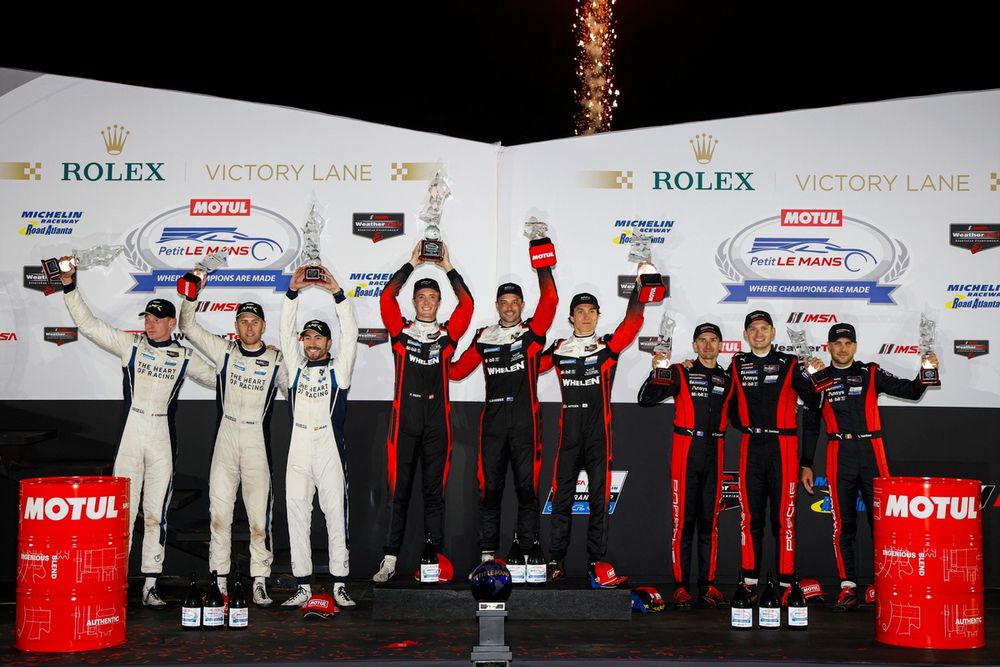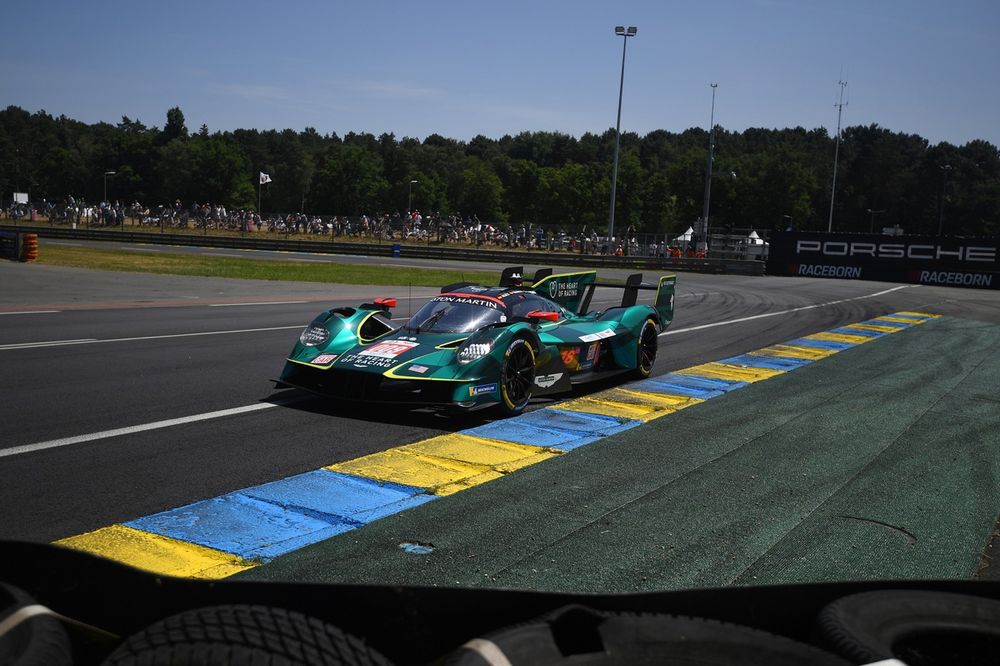The Heart of Racing team boss Ian James, right back at the start of the year, threw the idea of Aston Martin’s Valkyrie Le Mans Hypercar notching up a podium before its maiden season was out.
“That would be nice,” he said. It didn’t look very realistic over the first half of THOR’s parallel campaigns with the machine in the World Endurance Championship and the IMSA SportsCar Championship. But achieve it, a team and car that some had been quick to write off, did, in the final round of the latter series at Road Atlanta earlier this month.
More to the point, the second place for Ross Gunn, Roman De Angelis and Alex Riberas at the Petit Le Mans 10-hour event was neither a flash in the pan, nor the result of some kind of lucky break or strategic gamble in the rough and tumble of North American sportscar racing. The runner-up spot, just five seconds down on the winning Action Express Racing Cadillac, followed on from an upturn in form in the WEC.
The Valkyrie scored its best result of its world championship campaign at Fuji in September with fifth for the #009 car shared by Riberas and Marco Sorensen and had at least a sniff of a podium.
It was within a couple of tenths of the pace at Fuji, just as the sister #007 entry of Harry Tincknell and Tom Gamble had been three weeks earlier in wet conditions at Austin. They were looking good for some silverware until a late technical issue struck.
Then around the sweeps of Road Atlanta the Valkyrie was right up there. Over the final four hours of the race, run under green flag conditions uninterrupted by the safety car, the Aston was among the quickest cars if not the quickest. Counting the best 25 laps, it was slower on the averages only than the Action Express Caddy V-Series.R LMdh shared by Jack Aitken, Earl Bamber and Frederik Vesti, and by just a couple of hundredths. Increase the sample, and the Aston was the quicker car.

Petit Le Mans podium
Photo by: Michael L. Levitt / Lumen via Getty Images
To call it a dramatic turnaround for Aston wouldn’t be quite right. Don’t forget that Sorensen got #009 into the first round of Hyperpole qualifying for the top 15 cars at the Le Mans 24 Hours in June, nor the sixth place for the solo IMSA entry at Road America at the start of August. But the upward trajectory of the Valkyrie’s performance has steepened following the WEC summer break after the Interlagos round at the start of July.
That much was clear during free practice at Austin on its resumption in early September. At least one of the Astons was in the top six in each of the three sessions and then Sorensen put #009 into Hyperpole for the fastest 10 cars in opening qualifying.
Tincknell wasn’t totally surprised, he insists, because he “knew what was coming” for the second leg of the 2025 WEC starting in Texas. “We’ve had a load of electronic updates and that is where the gains have come,” he explained. “We’ve had time off and been able to refine the way all the systems on which these cars are so dependent work, that’s the electronic braking system, the traction control and the way they all work together. There are so many handling tools on these cars. With a first-year programme there is always plenty of low-hanging fruit.”
Aston and THOR have been picking that fruit after a change of focus following Le Mans. Both Valkyries made it to the finish of the French enduro and without any issues: neither car was wheeled into its pitbox and the engine cover never came off. It proved the durability of a car that had a solo endurance test prior to the race, an extra 12 hours of running on the IMSA car a couple of days after it had completed the Sebring 12 Hours.
“We raced at Sebring and then we continued with that car in order to give it as hard a time as possible to understand where we were durability-wise,” explains Adam Carter, head of endurance motorsport at Aston Martin.
“We had good results coming out of there, but it’s not quite the same as Le Mans. The dynamic chassis loads aren’t quite as high and you are not running the car at such consistently high straightline speeds. That puts different loading regimes on the engine, the gearbox, the wheelbearings.

#009 Aston Martin Thor Team Aston Martin Valkyrie: Alex Riberas, Marco Sorensen, Roman De Angelis
Photo by: Rainier Ehrhardt
“Le Mans was a nice box ticked, though we are not resting on our laurels because we have seen some great teams fail on the last lap of Le Mans. But we could say that we now have the endurance, but we were not at the pace we needed to be. Your development resources are always balanced between reliability and performance, and that allowed us to shift the bias towards the performance element.”
Carter expands upon his point: “This year was always going to be about building a programme. It’s a brand new organisation, so we knew that heading to Le Mans we had to get everyone operating together properly, working on the choreography if you like. You could say that we were going racing while still building the engine – while the engine was running! Not only did the car prove reliable at Le Mans, but we delivered as an organisation. That gave us the solid foundation on which to make that switch of focus.”
Having a reliable car has also been important in the learning process in today’s data-driven world. Aston and THOR came back from Le Mans with a lot of information. The drivers of the two cars, Gunn making up an all-British line-up in #007 and De Angelis joining Sorensen and Riberas in #009, pushed hard for the full 24 hours. There was no point in doing otherwise.
“Our mentality was to chuck it over the kerbs, drive it hard and see what happens,” said Tincknell. “You don’t learn much trying to nurse the car to the end of a 24-hour race.”
The switch of focus from reliability to performance halfway through the season explains why Aston has no plans for any evo joker upgrades for 2026. That, revealed Carter, would have been out of kilter with the development timeline for the Valkyrie. “We would have been doing the work on any joker before we understood the car that we’ve got and the direction in which we want to develop,” he explains.
The Valkyrie now appears to be a more lithe racing machine than at the start of the season. That improvement has been about using all the electronic tools available to Aston, though Carter doesn’t go into too much detail, staying away from the specifics. “We have worked on all the available chassis control systems that can influence the car’s balance from braking and turn-in, through mid-corner to exit, through all phases of the corner,” he said.

#007 Aston Martin Thor Team Aston Martin Valkyrie: Harry Tincknell, Tom Gamble
Photo by: FIAWEC – DPPI
The Valkyrie also works in the wet. Ahead of the Austin race, Tincknell wasn’t convinced about the potential performance. “If it’s wet,” said a driver, who had barely sampled the car on anything other than a dry track, “we’ll have to do our best.” But its best could have yielded a podium: Tincknell had passed and pulled away from the #94 Peugeot 9X8 2024 LMH that did collect the third-place trophy, before an engine issue resulting from track debris clogging the radiators. “It’s nice to know the car is quick in the wet,” he said after the race.
The pace the Valkyrie has shown over its past three appearances bodes well for the future, as Aston and THOR reach the end of their maiden season at the Bahrain 8 Hours on 8 November. There is an obvious caveat, however: the Balance of Performance. The Aston has been running at minimum weight and maximum power in both IMSA and WEC. That had to have some significance in the Atlanta performance.
The Michelin Raceway Road Atlanta, to give it its full name these days, measures just 2.54 miles and was crowded by 53 cars at the start of the race. The place is narrow and twisty with a single racing line in places, and has a long back straight. It was probably no coincidence that another hitherto recalcitrant machine also starred during the protracted period of the green-flag running to the end of the race. The Lamborghini SC63 LMDh that flew in Romain Grosjean’s hands in the final stages on the way to fourth was racing at the same weight and power as the Aston.
If Aston has really turned a corner, what can it achieve next year in WEC and IMSA? Tincknell points out the steps other manufacturers made from year one to year two. Porsche is the best example: the leap it took propelled it to championship success in both arenas. Carter clearly isn’t going to be as bold as to predict that Aston is going to follow suit; rather he talks about continuing to learn and building on what it has achieved at the back end of this year.
“The podium at Atlanta was a great result for the programme,” he said. “There has been a mix of manufacturers challenging for the podium at different races this year. We want to have the same opportunity – we want to compete.”
We want your opinion!
What would you like to see on Motorsport.com?
– The Motorsport.com Team
Disclaimer : This story is auto aggregated by a computer programme and has not been created or edited by DOWNTHENEWS. Publisher: motorsport.com





